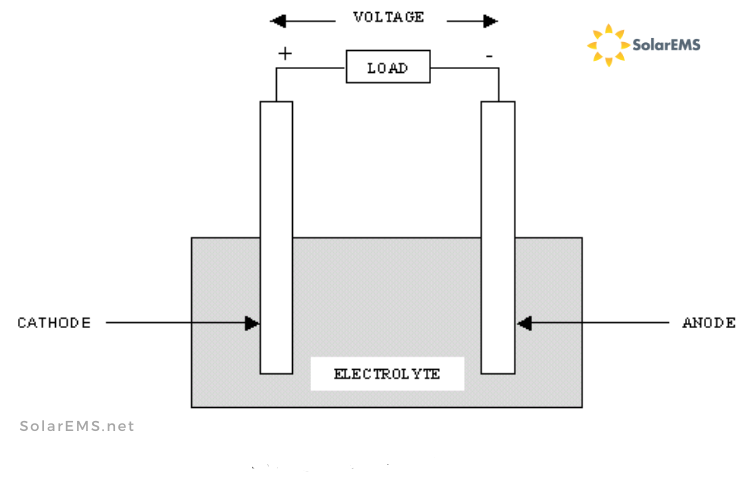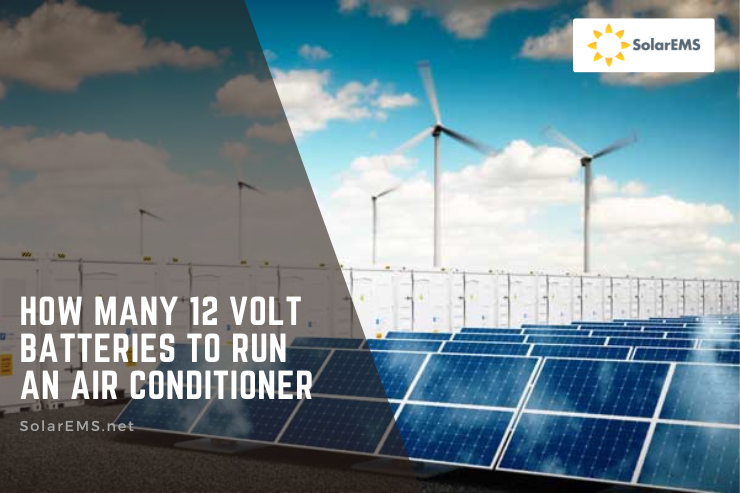In today’s day and age an air conditioner is becoming common in every home. Nowadays AC is a need rather than a want for common people because the average temperature of the world is rising every day. Normally, AC draws a great amount of electrical energy to run properly. Alternating current is used to operate AC but we can also use batteries to operate ACs. In this article, we are going to learn about how many 12-volt batteries to run an air conditioner.
What is a battery?

A battery is an electrochemical device that can be used to store electricity for future use if there is a case of uncertainty regarding a stable electric supply. It typically consists of one or more electrochemical cells that store energy in the form of chemical reactions, which can be released as electrical energy when needed. Batteries are commonly used to power portable electronic devices, vehicles, and homes during power outages, among other applications.
Types of batteries
Basically, there are four types of batteries:
- Flooded cell batteries
These kinds of batteries are the same as a “wet cell battery”. These are so-called because this kind of battery contains a liquid electrolyte in which electrodes are completely submerged. This kind of battery is one of the oldest invented batteries made by John Frederic Daniell in the year 1836. Normally it contains 35% sulfuric acid and 65% water as electrolytes, the cathode is made up of lead dioxide and the anode is made up of metallic lead. Like every battery, it has some pros and cons.
Advantages:
- It is pocket-friendly, water can be manually added when needed, easy replacement, and can withstand extreme weather conditions.
Disadvantages:
- One of the most prominent disadvantages of this kind of battery is that they require regular inspection and maintenance.
- Flooded cell batteries are very useful and are used in cars, stationery for uninterrupted power supplies and stand-alone energy systems, golf cart batteries, and flooded batteries for solar and emergency backup systems.
- AGM batteries
AGM(absorbed glass mat) batteries are also called SLA (sealed lead acid) batteries. These are so-called because there is a fine glass fiber separator between the negative and positive plates that help absorb all the battery acid. As it charges the sulfuric acid molecules break into two ions, positively charged hydrogen ions and negatively charged sulphate ions. The hydrogen ions absorb electrons from the cathode and become hydrogen atoms. The hydrogen atom reacts with the lead sulfate in the cathode and forms sulfuric acid and lead. Like every battery, it has some pros and cons.
Advantages:
- They give out a high power output and take less time to charge.
- They usually have a longer life span because they are durable.
Disadvantages:
- The major disadvantage is that they are expensive and cannot operate in harsh weather conditions with temperatures as low as 32 ℉ and above 104 ℉.
- AGM batteries are usually used in cars and trucks.
- They are a maintenance-free alternative to flooded cell batteries.
- Lithium phosphate batteries
Lithium phosphate is also called lithium ferro phosphate batteries. LFP(lithium phosphate batteries) has lithium iron phosphate as the cathode.
Some of the advantages of lithium phosphate batteries are:
- They require little or no maintenance.
- They have a longer lifespan as compared to other batteries.
- They are extremely safe even though lithium phosphate batteries are not the cheapest batteries in the market but because of their safety and a longer lifespan. Hence, it is proved that it is a great investment to go for.
- These kinds of batteries are widely used in the fields of solar energy installation, power tools, and EVs.
- Tesla battery modules
Tesla battery modules are mostly used in electric cars made by Tesla. These types of batteries use lithium-ion technology. Tesla uses cylindrical cells which tend to be more reliable as it burns less energy and provide a higher battery range. It uses graphite as its active anode. As it burns less energy, a smaller number of cells can be used for the same energy output and driving range thereby reducing costs.
How Many Batteries Do I Need for 8 Hours?
The number of batteries required to run an AC for a minimum of 8 hours will depend on the type of battery being used.
- Flooded cell batteries require 20 to 24 in 12 volts.
- AGM batteries need about 14 to 18 in 12-volt, 100 AH varieties.
- Lithium phosphate batteries require 12 to 16 in 12-volt, 100 AH varieties.
- Three Tesla battery modules can also be used to run an air conditioner for 8 hours.
How many 12-volt batteries to run an air conditioner?
To determine how many 12-volt batteries you need to run an air conditioner, you first need to calculate the energy consumption of the air conditioner in watt-hours (W/h). Once you have the energy consumption in W/h, you can calculate the battery bank capacity in amp-hours (Ah) at 12 volts (V).
To do this, you can use the following formula:
Battery Bank Capacity (Ah @ 12V) = (Energy Consumption (W/h) ÷ 12V) ÷ DOD (%)
Where DOD is the recommended depth of discharge for the batteries you are using.
For example, let’s say you have a 5000 BTU air conditioner that runs for 8 hours a day and consumes 2400 W/h on average. Assuming a recommended depth of discharge of 50%, you can calculate the battery bank capacity needed as follows:
Battery Bank Capacity (Ah @ 12V) = (2400 W//h ÷ 12V) ÷ 50%
Battery Bank Capacity (Ah @ 12V) = 40 Ah
To account for system losses and other factors, it is recommended to round up this number to 50 Ah. Therefore, you would need at least one 12V-50Ah battery to run this air conditioner.
| Air Conditioner Power Consumption (W) | Run Time (hours) | Energy Consumption (W/h) | Recommended DOD (%) | Battery Bank Capacity (Ah @ 12V) | Number of 12V Batteries Required |
| 2400 | 8 | 19200 | 50 | 40 | 1 |
What is the size of the battery bank needed to run an air conditioner?
- Determine the power consumption of your air conditioner in watts. This information is usually provided on the label or in the user manual. For example, let’s say your air conditioner consumes 1000 watts.
- Calculate the amperage required to run the air conditioner. Use the formula: Watts = Volts x Amps. For example, if you have a 12-volt battery bank, you would need 1000 watts ÷ 12 volts = 83.33 amps to run the air conditioner.
- Decide on the desired run time for your air conditioner in hours. For example, if you want your air conditioner to run for 3 hours, you would need to calculate the amp hours required to run the air conditioner for that time. Multiply the amperage required by the run time. For example, 83.33 amps x 3 hours = 250 amp hours.
- Calculate the battery capacity needed to supply the required amp hours. This depends on the type and quality of the battery you choose. For example, if you choose a deep cycle battery with a capacity of 100 amp hours, you would need at least 3 of them to provide a total of 300 amp hours (to account for the 70% discharge rate recommended for deep cycle batteries).
Conclusion
In my opinion, batteries can be a lifesaver when it comes to powering air conditioners in situations where you can’t rely on a stable electric supply. There are various types of batteries available, and each has its pros and cons. Make sure to choose one that matches your requirements.
If you’re like me, and you’ve ever been stuck in the sweltering heat without any power, you’ll understand just how important it is to have a reliable source of power for your air conditioner. I highly recommend investing in a good battery backup system if you live in an area with frequent power outages, or if you want to enjoy the comfort of your air conditioner without worrying about power supply issues.
FREQUENTLY ASKED QUESTIONS
How many batteries are needed to power an AC?
For a solar air conditioner, at least four 100-amp-hour lithium-iron phosphate batteries are needed to run the AC for at least six hours, while an AGM battery requires eight 100-amp-hour batteries. The exact number of batteries required can vary based on the specific AC unit and its power usage.
What is a battery?
A battery is a device that can be used to store electricity for future use if there is a case of uncertainty of a stable electric supply.
What are the types of batteries?
Flooded cell batteries
AGM batteries
Lithium phosphate batteries
Tesla battery modules
How many batteries are needed for an AC?
If you are looking to buy batteries that can able to run AC for a minimum of 6 hours, then you need to buy 4 100 amp hour lithium iron phosphate batteries. On the other hand, if you are considering to buy AGM batteries, you should buy at least 8 100 amp hour batteries.
How many 12-volt batteries to run an air conditioner?
If you are looking to buy AGM batteries, you should buy at least 14 to 18 batteries in 12 volt, 100 AH batteries and if you are looking to buy lithium batteries, you should buy 12 to 16 batteries in 12 volt, 100 AH batteries.

